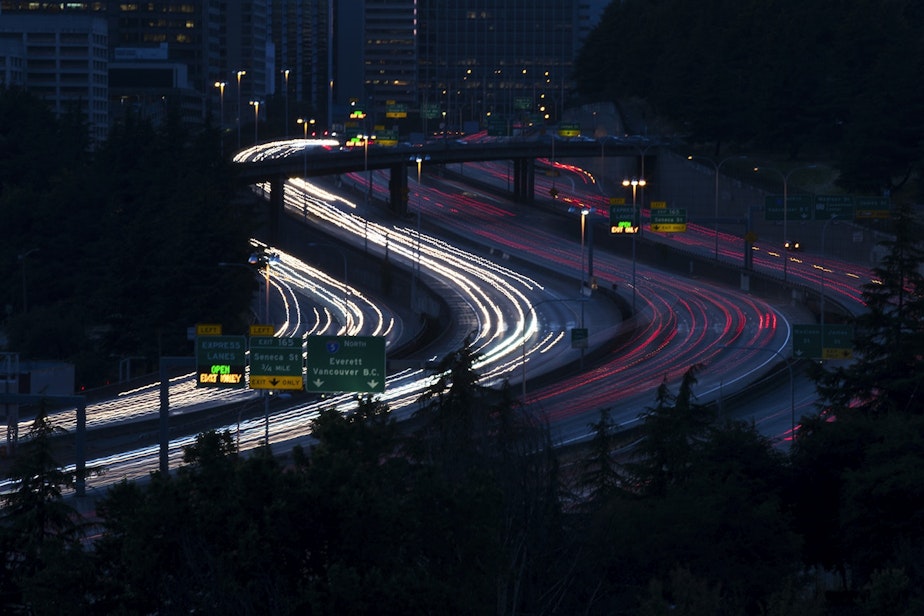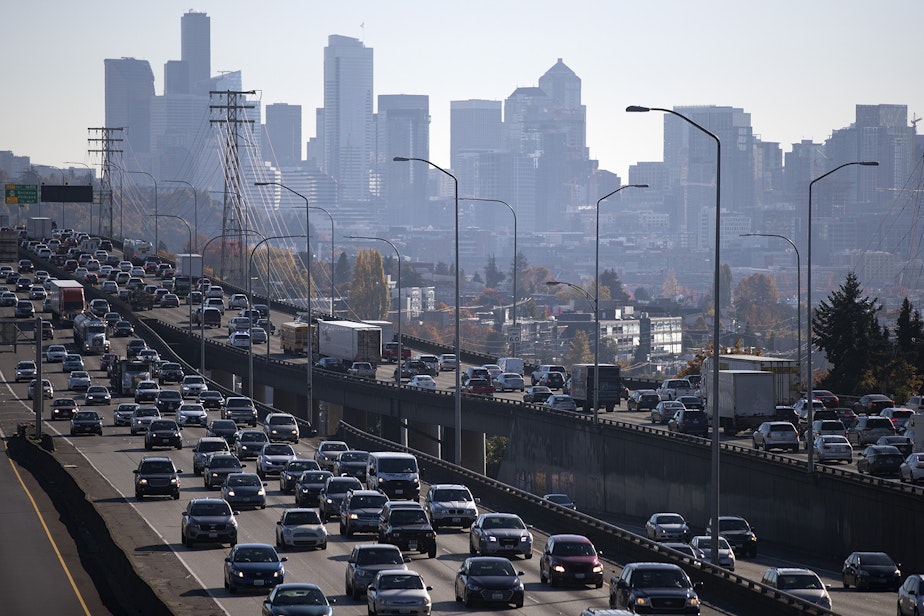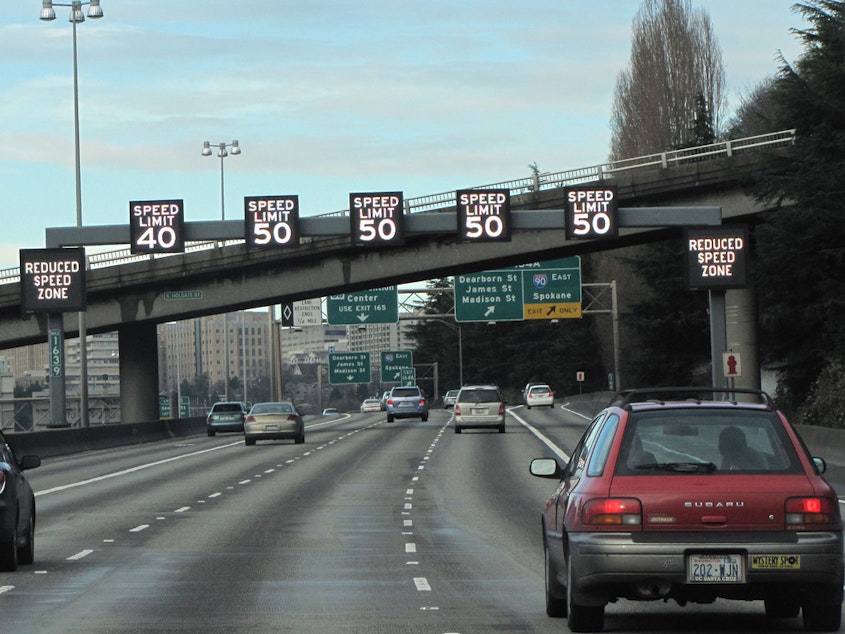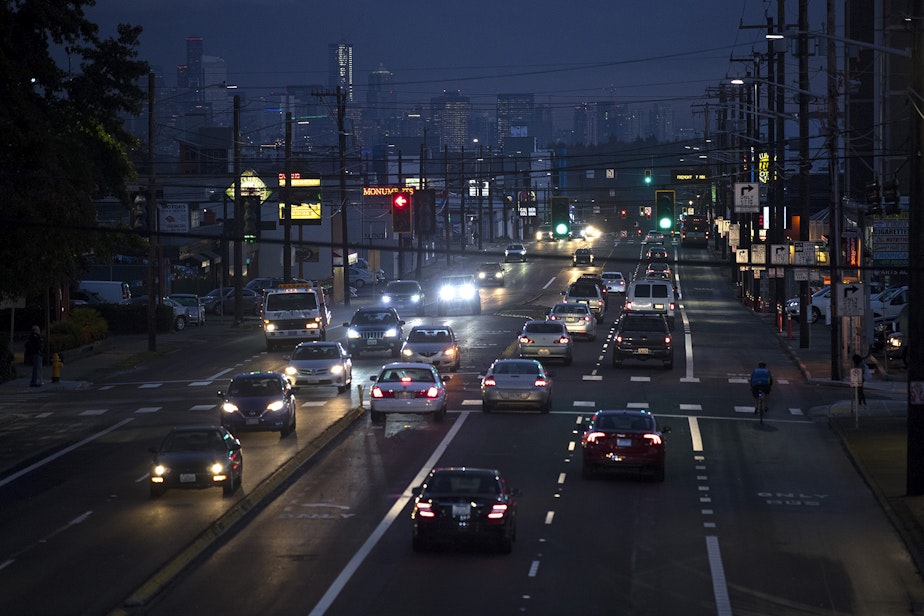Despite safety measures, promises, and plans, more people are dying on Washington roadways

The city of Seattle released its three-year plan to lower traffic fatalities Thursday in the wake of a statewide report that says the number of people killed on Washington roads hit a 33-year high.
The Vision Zero Action plan is backed by $162 million in Mayor Bruce Harrell’s proposed Transportation Levy, which would double the money for traffic safety improvements in Seattle. In 2024, the safety projects include:
- Installing 100 more pedestrian head-start walk signals, which give pedestrians several seconds to start crossing streets before the light turns green for vehicles.
- Adding 100 more “No Turn on Red” restrictions citywide.
- Plans for safety enhancements at key downtown intersections.
- Designating almost three miles of new bike lanes.
- Constructing 27 blocks of new sidewalks and walkways.
“We are absolutely committed to our Vision Zero goals,” said Venu Namini, who became Seattle’s first chief transportation safety officer in 2023, an upgrade from his previous position of city traffic engineer with the Seattle Department of Transportation.
“This particular action plan builds on our top-to-bottom review report recommendations, and identifies some very specific, actionable items that we can take in the near term to make advances towards our Vision Zero goals.”
The ultimate goal of the Vision Zero, as the name implies, is to reduce the number of traffic fatalities to zero by the year 2030. That’s a big ask considering the state and King County's numbers are moving in the opposite direction at an alarming rate, especially when it comes to impaired and distracted driving.
Sponsored
RELATED: In 'vexing' trend, traffic fatalities in Washington state continue to rise
Preliminary data from the Washington Traffic Safety Commission released this week documents 810 traffic deaths across Washington in 2023, a 10% increase from 2022, and the highest total since 1990. The stats include the most pedestrians killed in a single year (157) and the most motorcyclists fatally injured (141).

Some statewide trends that had been going in the right direction also changed course in 2023. The number of fatalities involving distracted drivers, which dipped in 2022, shot up by 36% in 2023. Also on the rise: the number of fatalities involving drug- or alcohol-impaired drivers, and the number of people killed who weren’t wearing seatbelts.
The trends are slightly better in Seattle, which has seen total fatalities and pedestrian fatalities fall since 2021. According to Ethan Bergerson, press secretary for the Seattle Department of Transportation, preliminary data shows deaths from people walking in Seattle was down to 12 in 2023, compared to 16 the year before. In terms of overall fatalities, the preliminary 2023 total was 27, compared to 30 in 2022.
Sponsored
RELATED: Even with Vision Zero, traffic fatalities remain high in Seattle
Washington Traffic Safety Commission Director Shelly Baldwin called the state total of 810 traffic deaths in 2023 “a shocking statistic.”
“Every number represents a life lost. A lost family member. A lost co-worker. A lost friend,” Baldwin said in a statement. “The people who mourn have had their lives changed forever.”

Mark McKechnie, the commission’s external relations director, said surveys and other data suggest that a lack of adequate law enforcement plays a key role in unsafe driving in Washington state.
Sponsored
“Even when we're fully staffed, we're dead last in the country in terms of law enforcement officers per capita,” McKechnie said. “So, if you think that we were already the worst state before Covid, and that we lost ground during Covid, I think that's one important piece to keep in mind, that enforcement really does matter.”
The Washington State Patrol is currently down 149 road troopers, with another 50 to 100 vacancies in specialty positions like detectives, supervisors, pilots, and command staff, said WSP Communications Director Chris Loftis in an email statement.
Loftis pointed to a graduation this week of the state patrol’s first lateral class as a small step in the right direction. But he said the problem of understaffing is acute, not only in Seattle, but across the country, and won’t be solved quickly.
Loftis said it was up to drivers to calm down, pay attention, and drive sober.
“We’re all in this together,” he said. “Lives depend on us, and we have to start making better decisions.”
Sponsored

McKechnie said speed also plays a key role in the severity of crashes.
For example, a crash in Renton that killed a mother and her three children earlier this year involved a teenager who was going 112 mph, almost three times the speed limit. That excessive speed multiplied the force of impact almost eight times, compared to a car traveling at the speed limit of 40 mph, McKechnie explained.
“One of the things that we really want to better educate the public about is that the force of a crash increases exponentially with speed,” he said.
Kirk Hovenkotter, executive director of Transportation Choices Coalition, put the emphasis of the increasing traffic fatalities less on human behavior and more on urban planning and street design. The coalition is a nonprofit group that advocates for safe, equitable, and sustainable streets, trails, and transit across Washington state.
Sponsored
Hovenkotter urged greater focus on redesigning “Main Street highways,” places like Aurora Avenue in Seattle, Highway 2 in Monroe, Division Street in Spokane, and Highway 303 in East Bremerton.
“These are the most dangerous roads in Washington, with a ton of businesses, a ton of residences on them,” he said. “They’re dangerous by design.”

Despite the troubling state report, Hovenkotter said he was encouraged by plans by the Seattle Department of Transportation to add safety measures along Aurora Avenue North, including sidewalks, bike lanes, and bus-only lanes.
In fact, the city of Seattle has made a number of moves to improve traffic safety in recent years, including the elevation of Nemani from city traffic engineer to chief transportation safety officer.
During a Vision Zero presentation to the City Council Transportation Committee in April, Councilmember Dan Strauss said he has seen a “incredible impact” in the wake of Nemani’s promotion.
Strauss, who was hit by a car in 2004, said he still suffers from chronic pain 20 years after that incident. Strauss said Nemani and his team should expand their data on the impact of traffic violence to include not only people who died from accidents, but also those who have been seriously injured.
“We cannot wait for lives to be lost. We can’t even wait for serious injuries. That’s my point,” he said. “Let’s go harder. Let’s go faster.”




